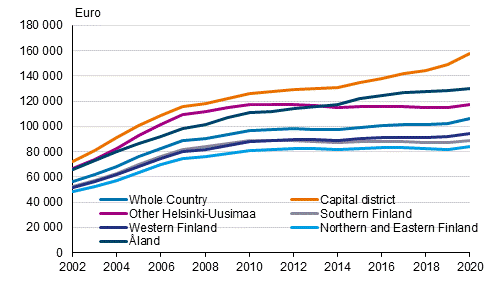Published: 24 June 2021
Household-dwelling units in Greater Helsinki have the highest housing loans
Statistics Finland’s statistics on indebtedness show that the average size of housing loan per household-dwelling unit with a housing loan was EUR 106,120 in 2020. The average housing loan grew by 3.5 per cent year-on-year in real terms. Household-dwelling units in Greater Helsinki had the largest housing loans, EUR 157,280, on average. Housing loans also grew clearly most in Greater Helsinki, by 5.6 per cent from the year before. The growth in average housing loans was around two per cent elsewhere in Finland. Housing loans were lowest among those with housing loans in Northern and Eastern Finland, EUR 83,710, on average.
Average housing loans of household-dwelling units with housing loans in 2002 to 2020, in 2020 money

In 2020, there were 1.46 million household-dwelling units in Finland that had debt. Thus, 53 per cent of all household-dwelling units were indebted household-dwelling units. Their total debt amounted to EUR 131.6 billion, which in real terms is 3.4 per cent more than in the previous year. Of household-dwelling units’ debts, EUR 92.2 billion were housing loans, EUR 8.7 billion were loans taken out for business purposes, and EUR 30.7 billion were other debts. Other debts include debts taken out for consumption and larger purchases and study loans. Other debts of household-dwelling units grew most, by 7.6 per cent from the previous year. Household dwelling-units’ housing loans grew by 2.6 per cent and loans taken out for business purposes contracted by 2.3 per cent compared with the previous year.
Good one-fifth of indebted household-dwelling units had debts of at most EUR 10,000 and one-half at most EUR 50,000 in 2020. A total of 180,100 household-dwelling units had debts of at least EUR 200,000, being seven per cent of all and 12 per cent of indebted household-dwelling units. The number of household-dwelling units this much in debt grew by seven per cent from the previous year. A total of 68,200 household-dwelling units had debts of at least EUR 300,000, that is, two per cent of all and five per cent of indebted household-dwelling units. The number of these household-dwelling units grew by 12 per cent from the previous year.
In 2020, a total of 868,900 household-dwelling units had housing loans, or 31 per cent of all. The number of household-dwelling units with housing loans fell slightly from the previous year. Examined by the age of the reference person, household-dwelling units where the reference person was aged 35 to 44 had most often a housing loan. Fifty-nine per cent of household-dwelling units of that age had housing loans. Housing loans were rarest in the age group of those aged under 25, where fewer than seven per cent of household-dwelling units had housing loans.
Housing loans were common for household-dwelling units that had children. Seventy-one per cent of household-dwelling units with two adults and children had housing loans in 2020. The average housing loan was EUR 143,110. The average housing loan of single-supporter families with housing loans was EUR 93,660. Childless household-dwelling units of two adults with housing loans had, on average, EUR 94,600 in housing loans and one-person household-dwelling units EUR 71,850.
In 2020, household-dwelling units paid EUR 1.6 billion in interests, which was in real terms 1.4 per cent less than in the year before. Of them, EUR 800 million were interest expenses from housing loans, which was five per cent less than in the year before. Households paid an average of EUR 1,100 in interests per indebted household-dwelling unit, while the corresponding figure in 2019 was EUR 1,130. On average, household-dwelling units with housing loans paid EUR 920 in interests on their housing loans.
Source: Indebtedness 2020, Statistics Finland
Inquiries: Ossi Kohvakka 029 551 3534, Auli Hämäläinen 029 551 3615, toimeentulo@stat.fi
Head of Department in charge: Hannele Orjala
Publication in pdf-format (170.7 kB)
- Tables
-
Tables in databases
Pick the data you need into tables, view the data as graphs, or download the data for your use.
Updated 24.6.2021
Official Statistics of Finland (OSF):
Indebtedness [e-publication].
ISSN=2489-3285. 2020. Helsinki: Statistics Finland [referred: 20.12.2025].
Access method: http://stat.fi/til/velk/2020/velk_2020_2021-06-24_tie_001_en.html

